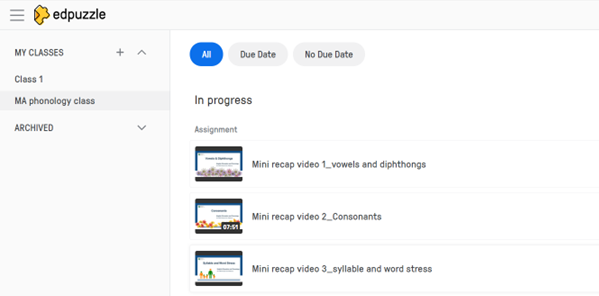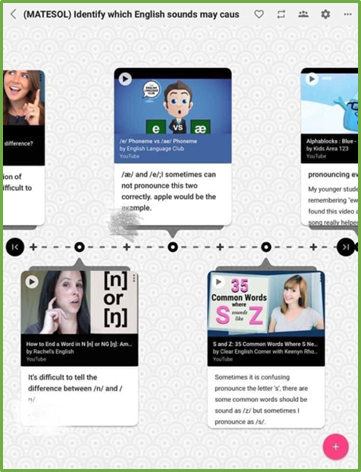
Introduction to Digital Education Tools in Language Teaching
Pronunciation teaching is considered as one of the major components in language teaching (Bakar & Abdullah, 2015). Online pronunciation teaching has become the popular teaching mode because of the pandemic of COVID-19. However, previous studies reported that online pronunciation teaching came across difficulties, and the major obstacles are the lack of interaction and supervision (Dumford & Miller, 2018; Hampel, 2006). The development of this e-teaching package aims to build effective online language teaching. Five e-tools were selected to help build up effective online teacher-learner collaboration and enhance teacher supervision.
The E-teaching Package
Edpuzzle
Edpuzzle is a platform on which teacher users can use to make videos for the course content. Teacher users can also add questions on the video and written feedback to the questions can also be provided. We developed five-minute instruction videos for content review. Learners watched the recap videos on phonetic topics (e.g., place and manner of articulation) and answered the questions at the same time. After they answered each question, they received immediate feedback of this question. This e-tool was used to review key concepts of the content knowledge and provide teacher feedback.
Nearpod
Nearpod helps customize lessons with assessments and check learners' understanding of the content knowledge. Different types of resources can be uploaded to the platform for the assessment design. We designed an online quiz for English word stress, and learners could perceive authentic English materials and produce the target language. Materials including pop songs and video clips produced by native and non-native speakers to provide learners with authentic examples and help learners acquire English word stress.
Padlet & Mentimeter
Padlet and Mentimeter are platforms on which teacher users can collect learners' opinions on a certain topic and learners can share their work with each other. We designed activities using Padlet and Mentimeter to collect and share learners' opinions on the course topics. Padlet could also help enhance online group work. Learners formed small groups (3-5 learners for each group), discussed the questions raised by the teacher, and shared their work to other groups through the platform. Mentimeter was used to collect learners' answers on the questions raised by the teacher, and learners' answers were shared with the whole class by providing a wordcloud of the answers.
Kahoot
Kahoot is a game-based learning platform on which learners can play and compete with their peers. We designed in-class competitions using Kahoot to activate learners' participation. Multiple-choice and true-or-false questions were developed to assess the content knowledge that learners learned and help them consolidate the knowledge.
Teaching Implications
To develop better and more effective online English phonetics and pronunciation teaching, the teachers should consider the following implications:
1. E-tools with different aims and purposes should be combined in online language teaching.
2. Oral feedback should be provided after learners finish the online tasks.
3. Peer feedback should also be enhanced, and teachers can use the e-tools, such as Flipgrid, to encourage peer feedback online.
4. More artificial intelligence products could also be integrated into online language teaching.
References
Bakar, Z. A., & Abdullah, M. R. (2015). Importance of correct pronunciation in spoken English: Dimension of second language learners’ perspective. Pertanika Journal of Social Sciences and Humanities, 23(8), 143-158.
Dumford, A. D., & Miller, A. L. (2018). Online learning in higher education: exploring advantages and disadvantages for engagement. Journal of Computing in Higher Education, 30(3), 452-465.
Hampel, R. (2006). Rethinking task design for the digital age: A framework for language teaching and learning in a synchronous online environment. ReCALL, 18(1), 105-121.
Hits: 875







